Polk Place
Polk Place was the home of 11th President of the United States James K. Polk and his wife Sarah Childress Polk, originally on Vine Street in Nashville, Tennessee before it was demolished in 1901.[1]
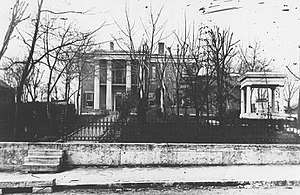
History and description
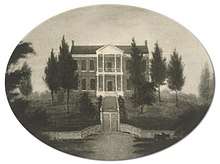
The home originally called "Grundy Place" was constructed for Attorney General Felix Grundy between 1815 and 1820 in the Palladian style of architecture, Grundy lived in the home till his death in 1840.[2] President Polk purchased the home while living in the White House in 1847 renaming it "Polk Place". Polk contracted Nashville architect J. M. Hughes to renovate the home for when he and Sarah returned to Tennessee after the end of his presidency. [3]
In the processes of modifying and renovating the home the back portion was destroyed by an accidental gunpowder explosion in 1847. With repairs underway the President wanted a more modern style, and requested Hughes to redesign the home in the Greek Revival style of architecture. Sarah went to inspect the construction and repairs of the home in early 1848 for their return.[4][5]
Upon returning to Tennessee in 1849, Polk Place was not yet completed, so he and Sarah returned to Columbia to his mother's home before returning to Nashville two weeks later when it was finished. It was the President's final residence where he died of cholera in 1849 at the age of 53. He had lived in the home for a little over thirty days. After his death his wife continued to reside there for 42 years until her death in 1891. The home was demolished in 1901, a decade after her death.
After President Polk's death
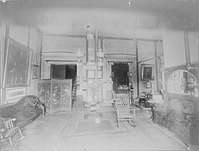
After the president's death first lady Sarah Polk lived in the home, she became a recluse for some time, barely leaving the mansion. She wouldn't find solace until fostering a great niece, Sarah Polk Jetton in the early 1850s. Soon she opened her home back up for invitations and hosting guests along with the occasional event. She hosted distinguished and popular guests throughout her widowhood, such as Adelicia Acklen a close friend, along with Abram Hewitt, Edward Cooper, John C. Calhoun II, John Catron, George Bancroft, Cyrus Field, William Vanderbilt, Sam Houston among numerous others, including Presidents Andrew Johnson, Rutherford B. Hayes and Grover Cleveland. [6][7][8][9]
During the Civil War, Polk Place was considered neutral ground by both the Confederate and Union armies, despite the fact that she had nephews fighting on the Confederate side. Union Generals Ulysses S. Grant, Don Carlos Buell, frequently paid their respects to the former first lady, as had Confederate generals briefly before the Union occupation.
(At the end of the war, Sarah's great niece Sarah Polk Jetton was married in the main parlor of Polk Place to a wealthy Nashville merchant, George Fall.)[10]
Legal dispute
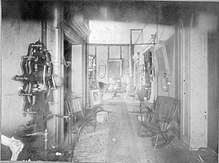
After a short illness, Mrs. Polk died at Polk Place in 1891, just short of her 88th birthday. (Originally Sarah's will was followed giving sole ownership of the home and its estate to her great niece Mrs. Fall, allowing her to live in the mansion for a few years after her death.) What followed was a long legal dispute centered on both wills by other Polk relatives, claiming Sarah's will was invalid and President Polk's will perpetuity had gone into effect that he could not foresee that far into the future. The president's nephew Tasker Polk, son of his brother William Hawkins Polk was the one that led the legal battle against Mrs. Fall.
A judge ruled in favor of Tasker and the Polk family giving control of the home to them. President Polk's tomb was originally located on the front lawn until 1893, when it was moved to the Tennessee State Capitol. The Polk Family could not agree on what to do with the home and did not want to follow the president's will, in which he expressed desire that a worthy and noble Polk relative run the home like the Hermitage. The state of Tennessee nearly acquired Polk Place and made it the governor's mansion. (At the time, the governor of Tennessee stayed in a hotel room.)
Finally, the state Supreme Court ordered the Polk family to sell the home and evenly split the money from the sale in 1900. Tasker would sell the home to Jacob M. Dickinson who then sold it to a developer and the mansion was demolished in 1901 to build a small apartment building.[11]
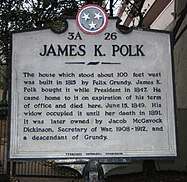
Today
The site has changed hands many times over the years. The YWCA bought the property in 1909 and built a new state-of-the-art facility. They sold the building in 1978 and moved to Woodmont Avenue. The Capitol Hotel (formerly Best Western) now occupies the former site of Polk Place in downtown Nashville.[12][13]
(An iron fountain, garden urns, and gate were preserved from the property and are now located at the James K. Polk Home.)[14]
References
- "James Knox Polk 11th President, 1845-1849 | Presidential Avenue". www.presidentialavenue.com. Archived from the original on 2016-04-14. Retrieved 2018-03-12.
- Byrnes, Mark Eaton (2001). James K. Polk: A Biographical Companion. ABC-CLIO. p. 96. ISBN 9781576070567.
- "Comfort in My Retirement". WHHA. Retrieved 2018-08-21.
- Thomas, Price. "Comfort in My Retirement". WHHA. Retrieved 2018-08-21.
- Tslablog (2016-04-15). "Library & Archives News: The Tennessee State Library and Archives Blog: When Powder Kegs Were Literal Rather Than Figurative". Library & Archives News. Retrieved 2018-08-21.
- Nelson, Anson; Nelson, Fanny (1892). Memorials of Sarah Childress Polk: Wife of the Eleventh President of the United States. A.D.F. Randolph.
- Nelson, Anson; Nelson, Fanny (1892). Memorials of Sarah Childress Polk: Wife of the Eleventh President of the United States. A.D.F. Randolph.
- Nelson, Anson; Nelson, Fanny (1892). Memorials of Sarah Childress Polk: Wife of the Eleventh President of the United States. A.D.F. Randolph. p. 219.
- "Comfort in My Retirement". WHHA. Retrieved 2018-08-21.
- "Sarah Polk | History of American Women". History of American Women. 2012-12-03. Retrieved 2018-04-02.
- "Remembering the lost home of our own James K. Polk". The Daily Herald. Retrieved 2018-08-21.
- "Roger Johnson's Welcome to America". Welcometoamerica.us. Retrieved 2017-02-11.
- Klo@NicksDad (2011-08-13). "POTUS historical sites: James K. Polk". Potushistoricalsites.blogspot.com. Retrieved 2017-02-11.
- "James K. Polk's Fountain". Flickr. Retrieved 2018-08-21.